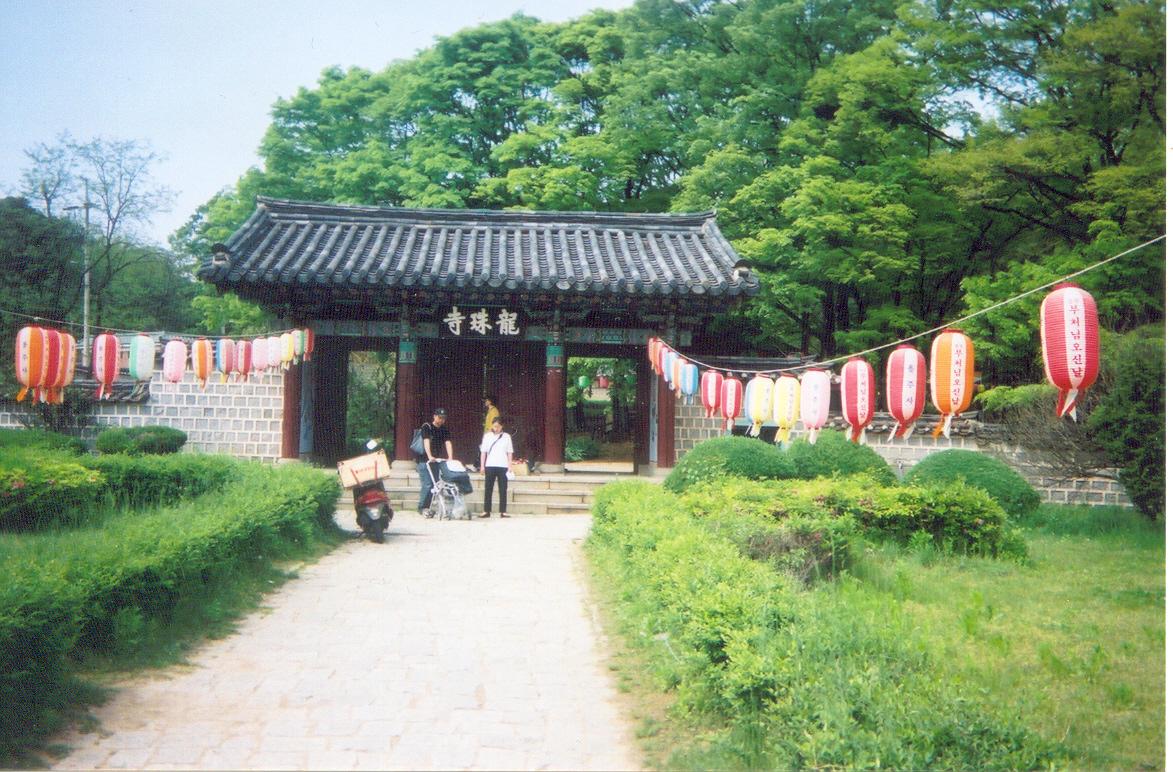- Yongjusa
Infobox Korean name

hangul=용주사
hanja=龍珠寺
rr=Yongjusa
mr=YongjusaYongjusa is a head temple of the
Jogye Order ofKorean Buddhism . It is located in on the slopes ofHwasan inTaean-eup ,Hwaseong , in the province ofGyeonggi ,South Korea . The temple's name means "dragon jewel temple."Two large bells in the temple are believed to date to the
Unified Silla period. One of them is designated national treasure 120.The temple was initially established in
854 AD , under the name Garyangsa. It was expanded in the 10th century. It was rebuilt in the late 18th century under the orders ofJeongjo in honor of his deceased father,Prince Sado . This is one of few cases where the Joseon royal house supported Buddhism directly. At this time the temple changed to its current name.The temple is located near
Seoul Subway Line 1 , and is also connected toSuwon by intercity bus.Ⅰ. History
Yongjusa is a Buddhist temple in Taean-eup, Hwaseong City, Gyeonggi Province, South Korea. It was first founded in 854 A.D. during the reign of Silla king Munseong under the name of "Kalyangsa". It was a famous seminary. But the temple was destroyed by fire during the Manchu war of 1636.
Jeongjo, the 22nd king of Joseon Dynasty, moved his father Prince Sado's grave from Mt. Baebong in Yangju to Mt. Hwasan in Taean-eup and named it "Hyeonryeuwon." Yongjusa was rebuilt to honor his father.
Ⅱ. King Jeongjo and Yongjusa
King Jeongjo's father, Prince Sado was forced to death cruelly by his own father, King Yongjo after being confined in a wooden rice chest for eight days. Jeongjo thought his father's soul couldn't reach heaven and was wandering in the Hades. He heard a Buddhist sermon related to parental love from the great monk Bokyeong and was impressed. He decided to comfort his father's soul and moved the tomb to Hwasan called the most blessed place in the world. The main role of Yongjusa was to protect Prince Sado's tomb and wish heavenly bliss. Yongjusa has historical significance in that it was rebuilt during the Joseon Dynasty when Buddhism was politically suppressed .
Ⅲ. Features and Treasures of Yongjusa
Daewoongbojeon
Daewoongbojeon was built in 1790 and is the central building that contains a statue of Buddha. Even though it is not such an old building, it kept the scale and pattern of the era in which it was built. It has a "Dapogye" pattern with 3 sections in front and 3 sections on each side and consists of doubled eaves and beautiful pictures of many colors and designs. It represents the features of temple architecture as well as specific characteristics of royal palace architecture.
The main platform painting in Daewoongbojeon
The main platform painting in Dawoongbojeon is a picture 3 meters in width and 4 meters in length. It was painted by Kim Hongdo, one of the most highly reputed Korean painters who was magistrate of the county at that time. The main platform painting is made up of two stages. On the upper stage, the Buddha statue is located between Yaksabul who relieves all living beings from diseases and pains on the left and Amitabul who will bring all living beings to heaven on the right. On lower stage, ten Buddhist saints, Buddha's disciples and four heavenly guardians of Buddhism are placed. An interesting feature is that everyone in the picture is concentrating their view toward Buddha. It has the round composition of a painting.
Ⅳ. Yongjusa as a religious community center
Yongjusa is one of the 31 head temples of Jogye Order of Korean Buddhism and currently has 80 branch temples and Buddhist hermitages distributed in southern Gyeonggi Province, such as at Suwon, Youngin and Anyang. It has almost 7,000 devotee households and lots of Buddhist masses are held. Many trainees practice asceticism and try to pursue the truth. On the other hand, monks in Yongjusa are introducing the wisdom of Buddha through missionary work. Also, in honor of Jeongjo's filial piety, it established institute for the study of filial conduct and contributes a community center for encouraging humanity.
ee also
*
List of Korea-related topics
*Korean Buddhist temples
*Korean Buddhism
*Religion in South Korea References
* [http://eng.koreatemple.net/travel/view_temple.asp?temple_id=2&code=A008002=11,00230000,37 Korea Temple]
* [http://eng.templestay.com/temple/list.asp?indiv_chk=1=11,00260000,37 Templestay]External links
* [http://www.yongjoosa.or.kr Official site, in Korean]
* [http://www.vrkg21.net/english/cyber/suwon/html/yung/yongjusadown.html Gyeonggi province profile]
* [http://www.hscity.net/english/html/tour/tour05_01.asp Hwaseong City profile]
* [http://eng.koreatemple.net/travel/view_temple.asp?temple_id=2&code=A008002 KoreaTemple profile]
* [http://www.buddhapia.com/buddhapi/eng/temple/korexp/html/bu8.html Buddhapia profile]
* [http://www.uwm.edu/~tholme/AKOREA/yongjusa.htm Personal account]
Wikimedia Foundation. 2010.
